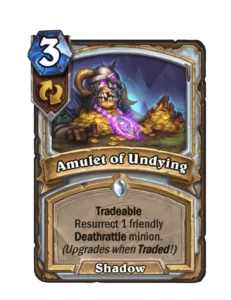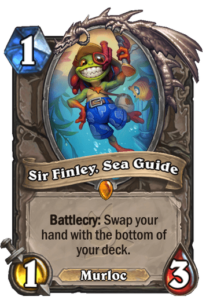Revisit Stormwind through Hearthstone’s Tradeable Keyword. Learn about notable interactions like Amulet of the Undying + Shuffle / Ice Trap.
Venture into Stormwind’s renowned Trade District, where you can exchange your cards for others in your deck, thanks to the Hearthstone Keyword: Tradeable.
United in Stormwind greets Hearthstone players with the unique Tradeable Keyword. The expansion takes place in the Alliance capital and seat of the humans. Just past Stormwind city’s Main Gate lies the bustling Trade District, where goods and services are exchanged. A seasoned player must learn how to get the best deals, so how does Tradeable work?
Hearthstone's new Keyword: Tradeable
Every new Hearthstone expansion brings forth new mechanics thematically tied to its lore. Hence, United in Stormwind proposes Questlines, the Tradeable Keyword and Profession Tools as weapons. These additions stay true to the city’s role as a main hub for the Alliance. Adventurers travel to Stormwind in order to acquire or resolve main quests, trade gear and items or perfect their professions.
Just as adventurers use items and then sell them, Tradeable cards can be used normally or traded. Trigger the Tradeable Hearthstone mechanic if you “Drag this into your deck to spend (1) Mana and draw a new card”. Otherwise, play the plain card to take advantage of its card-text and body.
Tradeable addresses several previous problems in Hearthstone and other card games, where a bad draw could sway or decide a match. The keyword can bring new life to a “dead” draw. Tech cards used to be a punishing inclusion, a double-edged sword. They helped improve certain matchups but otherwise hurt your overall gameplan. Now you can trade Rustrot Viper away if you don't need weapon removal. Early game, you can exchange that expensive Drakefire Amulet for more useful cards. The mechanic’s cheap cost of 1 Mana is also a welcome addition towards mana efficiency. Pro players swear by this!

(Image via Blizzard)

(Image via Blizzard)
Visual Cues
Hearthstone takes pride in its intuitive visuals. Tradeable cards possess a distinct marker to complement the Keyword's uses. The recycle symbol underneath the mana cost aims to emphasize the exchange taking place between the Tradeable card and the drawn card. An inspired visual cue while you are cycling through the deck. A unique animation occurs once selected from hand. Once you drag the Tradeable card out of your hand, your deck shines a green hue. This highlights the unique card to deck interaction, as opposed to other cards which only interact with the board or face. Once you hover the card above your deck, a green Tradeable sign renders atop. You are about to seal the deal! One of the top mechanics in-game, from flavor to execution!
Tradeable: Hearthstone Dev Clarifications
We've seen how intuitive visuals and succinct text complete the trademark Hearthstone polish. But Features Lead Celestalon kindly provides a look under the hood of the Tradeable Keyword.
“Trading does not count as playing a card”. This suggests that Trading does not trigger Counterspell, nor counts toward Motion Denied. Hearthstone copy effects such as Murozond the Infinite will also not mimic the Tradeable effect.
“You draw the top card of your deck (counts as a draw, like normal.)”. This synergizes with Voyage to the Sunken City Keyword Dredge. The mechanic manipulates the top card of your deck, thus allowing you to know what the Tradeable mechanic would draw.
“After drawing, the Tradeable card is shuffled into your deck (DOES keep enchantments, unlike normal.)”. This standout effect exponentially increases the power-level of certain cards you Trade away, turning otherwise inconspicuous cards into win-conditions. Luckily, a <hidden> interaction can counter Amulet of Undying and other such scaling Tradeables. More on that under Notable interactions!

(Image via Blizzard)

(Image via Blizzard)
“You can Trade while at 10 cards in hand; it doesn't burn the drawn card. You can't Trade if your deck is empty.”. The Keyword does prevent overdrawing, yet does not prevent fatigue. All good things must come to an end, it seems!
Notable Hearthstone interactions for the Tradeable Keyword
While even a novice can get a fair deal from Stormwind’s merchants, a seasoned adventurer should seek to know additional tips about the Trade District. Its Tradeable Keyword exhibits notable interactions with other Hearthstone cards. Call it a Trade(able) secret, if you will. This time, let us delve into some knowledge that would elevate your game from simple tavern-goer to savvy patron.
Shuffle
A common misconception concerns the interactions between buffed Hearthstone Tradeable cards and back to hand or back to deck effects. This is most noticeable with Priest’s occasional win-condition Amulet of Undying, as Shuffle effects reset its Deathrattle count. While we've buried grave offender Glide deep in Wild, some Shuffle cards still linger beneath Standard’s surface. Ghastly Gravedigger alert! This category also includes the iconic Legendary Sir Finley, Sea Guide. Watch out not to sabotage your Amulet gameplan with this popular pick!

(Image via Blizzard)

(Image via Blizzard)
Behold the “nitty gritty details” to demonstrate this. In Hearthstone game logic, moving a card from play to hand, from play to deck or from hand to deck constitutes a backward movement. As per the official rulebook, a backward movement is supposed to remove any buff or enchantment, unless explicitly stated.
Hence shuffling the card in the deck supersedes the enchantments. Tradeable cards’ buffs are resolved after triggering the keyword, as opposed to Kingsbane, a card which states “Always keeps enchantments”. The enchantments rely on the Tradeable Hearthstone Keyword trigger, which does not activate. Hints, for instance: no (1) Mana spent towards trading, no animation played. To illustrate, Paladin minion Immortal Prelate only keeps buffs after activating its Deathrattle. Backward movements such as Sap or Psychic Scream countered it as well.

(Image via Blizzard)

(Image via Blizzard)
Ice Trap
Take the case of Tradeable spell “Amulet of the Undying” and Hunter Secret “Ice Trap”. A similar interaction occurs while the secret returns the casted spell to hand. Once again, moving a card from play to hand is a backward movement and removes buffs. For example, minions that return from play to hand via Shadowstep or by triggering Freezing Trap are similarly reset.
In sum, these interactions seem intended. Previous Hearthstone mechanics such as Corrupt and Ranked spells upgraded to new, visually distinct cards when resolved. Thus, they could not be reset to their original versions when returned to hand or deck. Tradeable cards increase their count by means of a mere enchantment and this can be exploited accordingly.
While unclear in the Tradeable Keyword text, these notable interactions are consistent with Hearthstone rules. Hearthstone's signature style emphasizes an easy to read, clutter-free game with a clean interface. Thus simple short text has been preferred. “Drag this into your deck to spend (1) Mana and draw a new card” is the in-game description of choice. Additional clarifications such as “keeps enchantments” ‘if triggered’ reside in dev tweets and rulebooks.
Legacy
Moving onto the bigger picture, a point often overlooked is that the Tradeable Keyword marks a distinct shift in Hearthstone's direction. The game has begun distancing itself from previous eras of random Discover effects. The mechanic forgoes generating cards in favor of cheaply exploring players’ own decks. It also provides decent minions and effects alongside the Tradeable tag, adding extra flexibility. A year after Stormwind’s release, certain Tradeables are still staples of their class thanks to their multiple uses.

(Image via Blizzard)

(Image via Blizzard)
Another Hearthstone expansion, Voyage to the Sunken City, further iterates on this new, deck-centric direction. Its Dredge Keyword allows players to Discover a card from (the bottom of) their deck. Furthermore, that card is placed as their next draw. To paraphrase a great sitcom: “No random for you!”.
While “My kingdom for a horse!” is perhaps the most timeless trade quote, our Keyword isn’t doing too bad itself. It will be dearly missed if it leaves to Wild without proper card draw to replace it. With this in mind, devs have told us there is a chance.
To honor the keyword, consider this page a Tradeable card and draw for another article or guide in our repertoire. Like Stormwind, Esports.gg could be your main hub for more Hearthstone news and updates. Stay tuned!